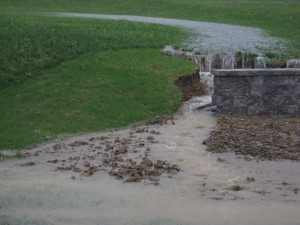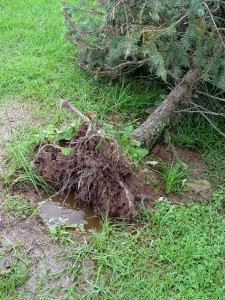Mending Lee
September 11th, 2011
I was admiring a new back-yard waterfall in South Hanover Twp. the day it flooded last week.
The only problem was that the couple who just moved there didn’t build it, plan it or want it.
This waterfall was an impromptu one that cut itself into the bank coming down from their neighbor’s yard.
It actually looked pretty nice, gushing out from around the big retaining wall they had built to head off the drainage problems they feared when their new home ended up 4 feet lower than planned.
It wasn’t as pretty farther out.
The newly graded “soil” – more a mix of clay and rock – washed itself out in a big pile on top of the couple’s new lawn.
That kind of erosion happened all over the place as Tropical Storm Lee dumped Biblical proportions of rain onto already saturated soil from last week’s remnants of Hurricane Irene.
Even some normally dry areas got surprise washouts.
Bottom line: We got a lot of fixin’ to do.
Give your first attention to any plants that got washed out or any trees and shrubs with exposed roots. It doesn’t take long for exposed roots to croak.
Get washed-out perennials and shrubs back into place ASAP. Odds are it was younger plants with not-so-well-anchored roots that came up and out anyway. Most of these should recover.
If you can’t get them back into their permanent home yet because the soil is still soggy, at least get them in a pot or planted in higher, drier ground.
Something else I’m concerned about is trees that lost root support in saturated soil. Unlike hurricanes and tornadoes that blow over trees on the spot, floods can do more lingering, insidious damage.
A tree might look fine now, but it could be loosened and at risk next time a heavy wind comes along. Or the saturated soil will kill off roots and weaken the support in the coming days.
Either way, keep an eye on big trees and have any assessed immediately that start to lean. The biggest threats are big trees that have a target nearby, i.e. a power line, a sidewalk, a driveway or your house.
Small trees and shrubs that are leaning might be salvageable. Prop them back up, tamp the soil and stake. With any luck, roots will regrow, and your plant will be back in business.
Another issue is all of that soil that eroded into new locations.
On one hand are the people who now have gullies or mini-cliffs where their banks used to be.
These washouts need to be addressed one way or another. Bare dirt will only continue to wash away and worsen the erosion every time it rains, not to mention dumping mud on the poor guy below.
If you can recover the washed-out soil and get it back in place, great. Be sure to plant grass or some sort of vegetation to help hold it in place. Now is the year’s best time window to do that.
Or better yet, build a retaining wall, redirect the source of the runoff by swale or drain pipe, or install a rock-lined channel to at least keep the bank from eroding.
The other side of that coin is where the soil ended up. If it sloughed off onto a lawn or over a landscape bed, it needs to come off. Get out the shovel and rake.
Tree roots can withstand the addition of maybe 3 or 4 inches of soil before it threatens health. Shrubs can take almost that much.
But even 2 or 3 inches of soil up against perennial stems or over top of turfgrass is enough to rot and smother. Rake it off or tell the guy uphill to come and get it.
He might like to have it back to fill in his gully.









